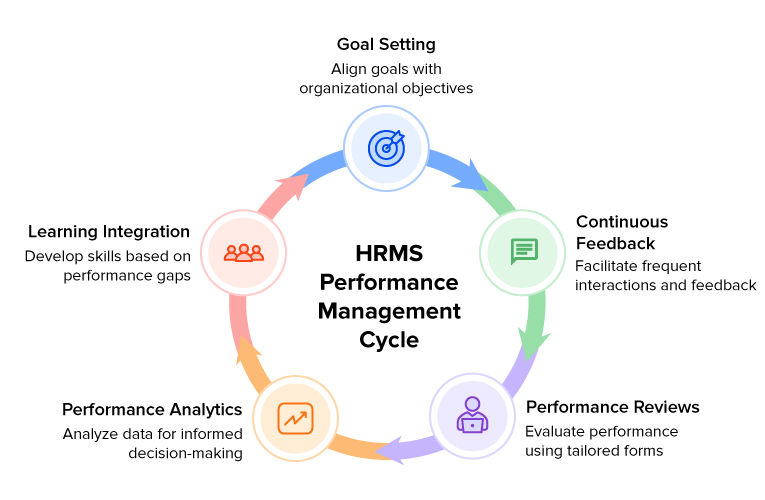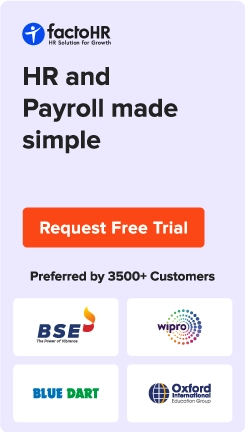How HRMS Transforms Performance Management in 2026

Table of Contents
Evaluating employee performance is a critical process for any organization. Performance assessment identifies skill gaps and assists in designing tailored learning and development programs.
Also, an organization must perform competently to survive in this competitive market in the long run.
In an era where companies embrace AI and automation, manually managing employee performance would considerably disadvantage your business. According to Deloitte, 74% of correspondents acknowledge the significance of adopting more effective methods to evaluate worker performance. This indicates that organizations should shift away from conventional performance evaluation methods and consider new ways to measure worker productivity.
In this case, advanced HRMS solutions could be the best option.
For context, Human Resource Management Software (HRMS) is an integrated system that automates manual tasks. It streamlines several HR operations, including payroll processing, employee onboarding, and performance management. HRMS transforms performance management with features such as OKR-based goal creation and continuous feedback.
Thus, having an HRMS for performance management is a must.
This blog outlines the benefits and important factors to consider when selecting an HRMS for performance management, enabling you to make an informed decision.

Traditional Performance Management Challenges
Relying on manual processes for tracking employee performance could pose several challenges.
The HR department would face additional strain from administrative duties like monitoring each employee’s performance in a document or spreadsheet. Employees would find receiving timely feedback and evaluations on their recent work challenging. Let’s look at these challenges in some detail.
More Time-Consuming Due to Increased Administrative Burden
Every process, such as evaluation, scheduling, and follow-ups, would become more labor-intensive if done manually.
This could lead to an overworked and underproductive HR department.
Inconsistency and Bias in Evaluation
Manual performance evaluation could result in two significant issues. These problems are unintentional errors that might cause document inconsistencies and a non-standardized format that leaves room for favoritism and bias.
Lack of Real-Time Feedback and Monitoring
Monitoring employee performance in real time poses challenges, as manual methods require significant time to assess and align performance with business goals. Additionally, coordinating meeting schedules between employees and managers could be challenging.
Poor Employee Engagement and Lack of Transparency
An organization might encounter issues with low employee engagement stemming from insufficient real-time recognition. Furthermore, manual performance management systems can result in unclear criteria for evaluating performance. This might result in a less transparent performance evaluation.
Difficulty in Tracking Progress Towards Goals
Manually storing and updating data could make it challenging to track progress towards goals. Dispersed data, missed details, and review delays complicate tracking and meeting goals on time.

How does HRMS Streamline Performance Management?
HRMS transforms performance management by offering features like integration with & D modules, multi-level goal creation, and continuous feedback among others.

Goal Setting and Alignment
An HRMS assists in developing and aligning goals through various features. Customizable templates help you create goals for traditional OKR-based goal creation and a 360-degree review process. Similarly, flexible review cycles offer several options for measuring employee performance, including various methods such as stars or ratings.
Continuous Feedback and Monitoring
HR software facilitates continuous feedback with a 360-degree feedback mechanism, automated review cycles, and real-time performance tracking. This promotes frequent interactions between employees and managers.
Performance Reviews and Evaluation
HR software helps organizations tailor appraisal forms and reviews by offering customizable templates. This helps assess employee performance for specific competencies based on different roles.
Also, automated performance scheduling and review cycles help with timely performance reviews.
360-Degree Feedback
360-degree feedback evaluates employee performance based on feedback from other employees, managers, and clients. Some solutions also allow anonymous feedback, providing an unbiased and fair performance evaluation. An integrated Employee Self-Service portal also empowers employees to give feedback to their co-workers.
Performance Analytics and Reporting
Detailed dashboards, report generation, and employee performance analytics facilitate informed decision-making. Other capabilities, such as automated performance reviews and measurable competency parameters, help ensure accurate and timely performance reviews.
Integration with Learning and Development
An integrated performance and learning management system contributes to employees’ personal growth and aligns their career paths with organizational goals. This system also improves employee performance by developing skills based on potential competency shortfalls in performance evaluations.

Benefits of Using HRMS for Performance Management
An HRMS increases efficiency and reduces administrative costs. It also contributes to a fair and accurate evaluation of employee performance. Most importantly, using HR software to assess employee performance would also enhance employee engagement. Let’s explore these benefits in some detail.
Increased Efficiency and Reduced Administrative Costs
A performance management software increases efficiency and reduces administrative costs. It automates manual tasks such as scheduling, goal tracking, and conducting periodic performance reviews. Thus freeing up time, effort, and resources for the HR department.
Improved Accuracy and Objectivity in Evaluations
HR software facilitates precise performance assessments by helping to establish measurable objectives and competency standards. The 360-degree feedback mechanism encourages anonymous feedback from internal and external stakeholders, promoting fair and impartial performance evaluations.
Enhanced Employee Engagement and Motivation
An integratedESS portal and HRMS software can improve employee engagement. Employees can enter their OKRs, submit a performance review, and download their performance assessments.
Better Alignment of Individual and Organizational Goals
Creating multilevel goals helps align personal and organizational objectives by enabling the development of main goals alongside sub-goals. Another useful feature is real-time employee performance tracking, as it helps improve employee performance by allowing frequent reviews.
Facilitating Continuous Improvement and Development
There are mainly two features that assist in continuous learning and development.
- Integrated performance and learning management systems help address potential skill gaps in employees based on performance audits.
- Continuous feedback facilitates regular performance assessments.
Data-Driven Insights for Talent Management Decisions
According to Gartner, only 21% of HR leaders believe their organizations are effective at using data to shape talent acquisition and recruiting strategies.
HRMS software offers comprehensive reports and clutter-free dashboards for accessing data related to employee performance. This real-time access to talent data helps in developing and retaining top talent and subsequently improves organizational performance.

What are the Factors You Should Consider before Choosing the Right HRMS for Performance Management?
Create a checklist of these factors before choosing an HRMS for performance management.
- Customization and flexibility: Choose an HRMS software tailored to your organizational needs.
- Ease of use for employees and managers: Prefer a solution that is easy to use and has a clutter-free interface.
- Integration capabilities with other HR modules: An integrated solution would facilitate seamless data migrations and employee performance tracking.
- Reporting and analytics features: Opt for a solution that offers customizable dashboards and pre-made reports.
- Vendor reputation and support: Choose a vendor that offers comprehensive support and training for the chosen solution. Read reviews and testimonials to learn more about the vendor’s reputation.
- Scalability and future-proofing: Consider a scalable solution that seamlessly accommodates additional employees.
💡 To make a better choice, you can review our comparison of the top HRMS solutions in India, which highlights leading vendors and their strengths.
Conclusion
HRMS transforms performance management by streamlining performance assessment through automation capabilities. Performance management software is essential for organizations to foster a performance-driven culture.
Such a system would facilitate constructive feedback and assist employees in continuous growth, contributing to an organization’s overall growth.
Features such as performance monitoring, configurable goal creation, and integration with learning management systems make it indispensable for businesses.
Implement cutting-edge performance management software today and create a performance-driven culture with transparent, impartial, automated performance evaluation!
factoHR’s performance management software is a one-stop solution, offering state-of-the-art features to transform your workforce appraisals. Create and track any number of goals and competencies, with multiple measurement parameters, and align employee goals with business outcomes. Leverage analytics for actionable insights. You can also configure a review cycle based on various criteria, including the approval hierarchy, types of incentives, and more.Schedule a demo with factoHR to transform your performance appraisal process with next-generation performance management software!
How does Performance Management Improve Employee Performance?
Performance management improves employee performance with the following –
- Goal setting establishes organizational objectives and aligns employee aspirations with desired results.
- Continuous feedback facilitates regular communication between employees and managers.
- Improves employee engagement and enhances productivity.
- Facilitates skill-based learning as it’s integrated with learning and development programs.
What is the Role of HR in Performance Appraisal?
HR plays a pivotal role in performance appraisal and is a part of all the processes, such as –
- Creating and standardizing the appraisal process,
- Training employees and managers,
- Monitoring performance evaluations,
- Collecting employee performance data to identify skill gaps and areas for development,
- Conducting periodic performance reviews.
How Secure is Employee Performance Data in HRMS?
Reputable HRMS solutions implement the following practices for ensuring data security –
- Role-based access control,
- End-to-end data encryption,
- Having multiple audit trails,
- Complying with international standards such as ISO 27001:2013 and SOC 2 Type II certifications, and
- Supporting multi-factor authentication.
Grow your business with factoHR today
Focus on the significant decision-making tasks, transfer all your common repetitive HR tasks to factoHR and see the things falling into their place.

© 2025 Copyright factoHR


